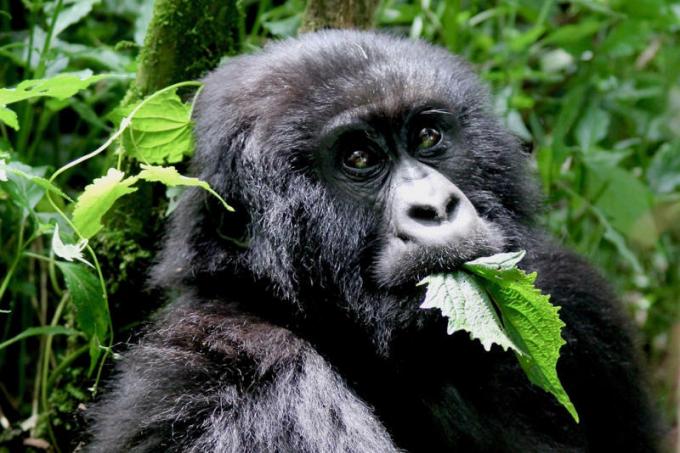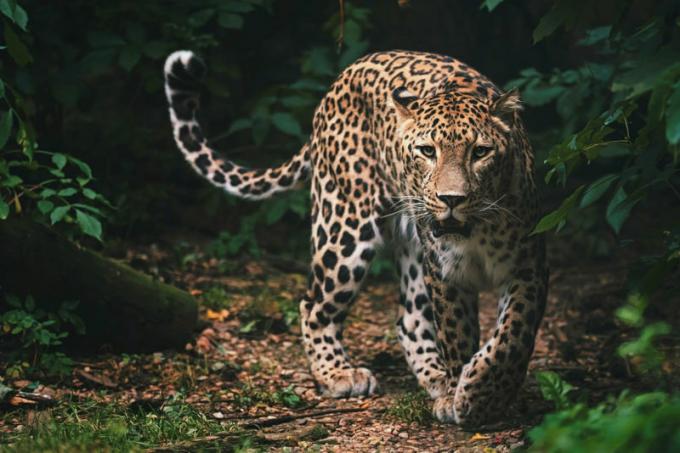You gorillas are the largest living primates in the world. They inhabit the central region of Africa, being divided into two species, each of which is subdivided into two others. We share 98.4% of our DNA with them, and their strength exceeds ours by up to six times. Gorillas live in groups, and their social structure is divided into dominant male, immature males and females with their young.
Sadly, gorillas face threats of extinction, with hunting, trade, habitat destruction and disease all contributing to this scenario. Urgent conservation measures are needed to ensure the survival of these animals and the permanence of their ecological roles.
Read too: Monkeys — other mammalian animals that belong to the order of primates
summary about gorillas
- Gorillas are primates of the genus gorilla. It is considered the largest living primate.
- They have two species subdivided into two subspecies each.
- They share 98.4% of their DNA with humans.
- They are mostly herbivores, but can feed on small invertebrates.
- They inhabit the tropical and subtropical forests of Central Africa.
- They have a low reproductive rate, making it difficult for declining populations to recover.
- They beat their chests as a way of showing strength.
- They live in groups. Each group features a single dominant male, also known as a 'silverback'.
- They are threatened with extinction, and among the main reasons that contribute to the decline in the number of individuals are hunting, destruction of habitats and diseases.
gorilla features
the gorillas they aremammals primates of the genus gorilla, and its biological classification is as follows:
Kingdom: Animalia
Phylum: Chordata
Class: Mammalia
Order: Primates
Family: Hominidae
Subfamily: Homininae
Tribe: Gorillini
Gender: gorilla
They share approximately 98.4% of DNA with humans, making them closely related along with chimpanzees and bonobos. They are even in the same subfamily as humans: Homininae.
the gorillas are the largest primates in existence. Males are larger than females, measuring 1.7 to 1.8 meters in height and weighing 135 to 180 kilograms. Dominant or “silver back” males can exceed these measurements. Females, in turn, are about 1.5 meters long and weigh between 68 and 110 kilos. the gorillas have a life expectancy of between 30 and 50 years.
Generally, gorillas move on all fours, using front extremities for walking and climbing. Its arms span is much greater than its height, reaching 2.6 meters. The stomach area is larger than the chest area due to the long digestive tract needed to digest your fibrous food. The unique wrinkles around the nose allow for individual identification.
the gorillas prepare a “nest” or bed to sleep in each afternoon, on branches or on the ground. The dominant male usually sleeps at ground level. Considered highly intelligent, some captive gorillas have learned sign language.
gorilla types
There are two species of gorilla. Each species has two subspecies. The respective popular and scientific names of each are:
-
Species: Western gorilla (gorilla gorilla)
- Subspecies: Western Lowland Gorilla (Gorilla gorilla gorilla) and cross river gorilla (Gorilla gorilla diehli)
-
Species:eastern gorilla (beringei gorilla)
- Subspecies: Mountains gorilla (Gorilla Beringei Beringei) and Grauer's Gorilla (Gorilla beringeigraderi)
Due to the few differences between the species, for a long time it was believed that they were only one. The main distinctions between the types of gorillas are: the sound of vocalization when communicating with the group, the size and morphology of the nose and body size (the eastern gorilla is slightly larger than the western gorilla).
gorilla habitat
the gorillas inhabit tropical and subtropical areas of Central Africa. The two species are separated by the Congo River by a distance of approximately 750 kilometers. The western gorilla lives in the west of the continent, while the eastern gorilla resides in the east of the African continent. This wide geographic distribution helps them to occupy different habitats.
gorilla feeding

the gorillas are predominantly herbivorous animals, which means that their food is mainly based on plants. They dedicate almost half of their day to searching for stalks, bamboo shoots, tree bark and a wide variety of fruits to feed on. Furthermore, They can also feed on invertebrates., and some subspecies actively seek out termite nests to feed on their larvae.
reproduction of gorillas
Most current information on gorilla reproduction comes from individuals in captivity. Females become sexually mature at around age seven or eight, but do not start reproducing until a few years later, at approximately age ten. Males mature even later, at around 11–13 years old. After the first ovulatory cycle, they go through a period of about two years during which they are unable to conceive a young.
the gorillas can copulate at any time of the year, and females are in heat between one and two days a month. Both female and male can perform courtship. It is usually the dominant males who have the right to copulate with females.

The female's gestation lasts approximately eight months.. Each female usually gives birth to only one pup every four to six years and, over her lifetime, only three or four pups. This low reproduction rate makes it difficult for gorilla populations to recover after declines, making them vulnerable to environmental threats and habitat loss. The calf lives with its mother for the first three to four years of age..
habits of gorillas
→ Why do gorillas beat their chests?

Gorillas beat their chests to demonstrate strength and courage among their peers., communicating his power in case of a fight. This sound can be heard up to a kilometer away. The act of beating the chest is also important for females to evaluate possible reproductive partners, in order to choose the one with greater strength.
→ Social structure of gorillas

the gorillas are highly social animals that live in groups usually composed of five to ten individuals, and each of these groups is led by a dominant male. This dominant male is known as a “silverback” because of the silver coloration on its back. All males acquire this coloration upon reaching maturity, but only one becomes the leader of the group. This male maintains his position for years, and when he dies, the group disperses. If defeated by another male, the winner takes the lead. The dominant male has easy access to females during the heat period, as his display of strength makes him more attractive to females. The dominant male also helps defend the group from predator attacks.
In addition to the dominant male, there are other males in the group, usually immature, who help protect the females and their young. Each group normally contains about four females and their young. This social organization strengthens group protection and ensures the survival of gorillas in their natural habitat. For example, when a gorilla spots a predator, it vocalizes to alert the rest of the group. All gather around the dominant male, who usually defends them from sighted danger.
How strong is a gorilla?
the gorilla It is the strongest primate in the world, being able to lift up to ten times its own weight.. Their well-developed muscles in their arms, shoulders, neck and back contribute to a strength up to six times that of humans. Its strength is mainly used to protect its group from possible threats.
Who is the strongest gorilla in the world?
There is no significant difference in strength between gorilla species and subspecies. However, within the same group, the strongest gorilla is often the dominant male. He exerts his strength to lead the group and ensure their protection.
Who has more strength: the gorilla or the lion?
Given the physical and social characteristics of each species, in addition to the lack of observations that could help in measuring the difference in strength between these animals, it is difficult to establish whether the stronger is the gorilla or the lion.

However, it is known that the size, strength and social structure of the gorilla make even the presence of natural predators difficult for this animal. So far, it is known that the leopards (big carnivorous cats) are the only animals capable of killing an adult gorilla. One of its advantages is its ability to climb trees, places where gorillas build their nests. Generally, leopards focus on hunting young individuals or cubs, avoiding the dominant male.
See too: African elephant — the largest species of land mammal existing on our planet
gorilla extinction
According to the International Union for Conservation of Nature and Natural Resources (IUCN) Red List, the two species of gorillas, western gorilla (gorilla gorilla) and eastern gorilla (beringei gorilla), are threatened with extinction.. Of the four existing subspecies, the mountain gorilla is the most endangered, with an estimated number of individuals of around 1,000.
The risk of gorilla extinction is attributed to the destruction of their natural habitat by human activities such as deforestation and urban expansion, as well as poaching. In addition, they face the threat of transmission of different viruses, such as Ebola and even the virus that causes Covid-19, which can have devastating impacts on their populations. These factors combined make the need for effective conservation actions to protect these animals urgent.
Sources
AYALA, R. Why do the gorillas strike their chest and other facts about the king of primates. National Geographic, 2021. Available in: https://www.ngenespanol.com/animales/curiosidades-sobre-los-gorilas/.
FORCINA, G. et al. From groups to communities in western lowland gorillas. Proc Biol Sci. 2019. 286(1896): 20182019.
GORILLA WORLD. Gorilla Facts and Information. Gorillas World, c2023. Available in: https://www.gorillas-world.com/.
MORRISON, R.E. et al. Hierarchical social modularity in gorillas. Proc Biol Sci. 2019. 286(1906): 20190681.
NATIONAL GEOGRAPHIC. Reports and photographs of Gorillas in National Geographic. National Geographic, [s. d.]. Available in: https://www.nationalgeographic.com.es/animales/gorilas.
WWF. Gorilla - Species. WWF, c2023. Available in: https://www.worldwildlife.org/species/gorilla.



